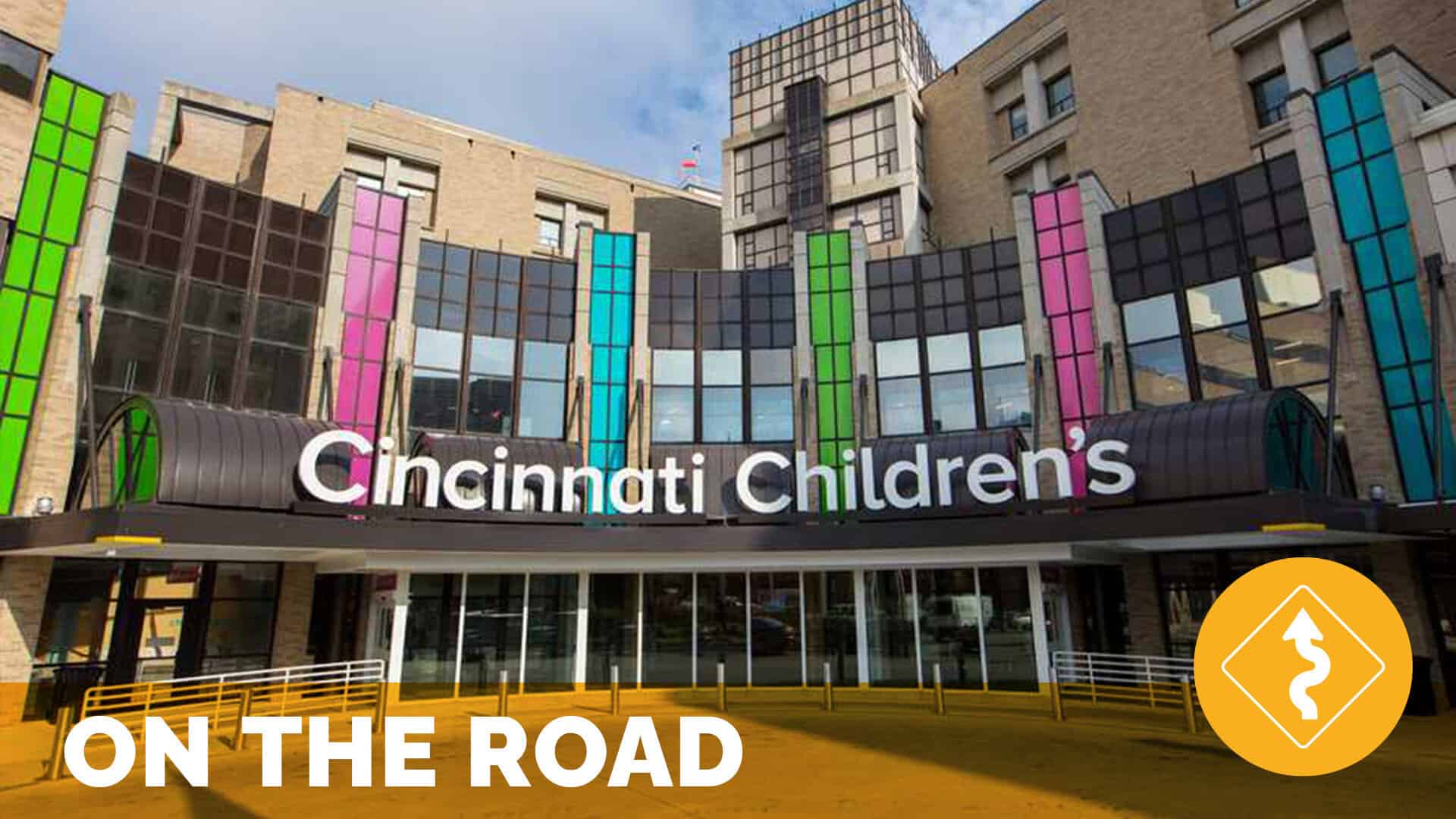Being Better Together: Creating High Reliability and Experience Excellence

On the Road with Cincinnati Children’s – March 2014
by Jason A. Wolf
As I began my third visit to a children’s hospital in our On the Road series, I was reminded of how much the pediatric setting magnifies the intensity, emotion and miraculous nature of the healthcare experience. As I entered the main hallway connecting this active children’s medical center, I was immediately struck by a sense of warmth and community, exemplified in how people interacted with one another and with patients and families.
Exploring the significance of patient experience in the pediatric setting is also a way in which we can unequivocally acknowledge that patients and their families are all critical components of the care experience. To see the faces of wonder and, on occasion, an absence of fear or even excitement in the children I passed, to the concern and intention seen in the eyes of parents and family members (and one I could relate to being a new father) reinforces the point that the healthcare experience itself impacts more than the person for whom we are caring.
My time with Cincinnati Children’s supported that message with an emerging clarity in purpose and intentional focus on experience improvement throughout the facility. My host and guide for the day, Jason Phibbs, Project Manager, Patient Experience and the recently appointed Anne Boat, MD, Patient Experience Officer, provided a powerful overview to the efforts taking place to address and improve the experience for patients and families.
The key themes were powerful and not surprisingly similar to those we find in many organizations successfully focusing on experience excellence. They reinforced the power of people, the importance of the culture of the organization, an unwavering focus on safety and quality outcomes and the realization that experience plays out at the intersection of these elements. But they also provided an intriguing and unique twist to how I have seen others address the experience issue – by engaging in a significant focus on data, how to best address what it reveals and the intention to build a high reliability organization and the openness to examine experience efforts from the perspective of design thinking and user-centered design.
Foundational Efforts
My day began with a quick tour of the facility to get a sense of its bones and how the physicality of the space was being realigned to provide better guest experiences overall. From clear signage to visible markers, the medical center flowed in a rhythmic fashion and an energetic pace of people moving to and from appointments, visits, etc. We were accompanied on our tour by Dr. Patricia Chambers, an emergency medicine physician and a true physician champion for the patient experience. Dr. Chambers provided an overview of the efforts in the ED, one of the busiest and physically largest EDs in the country across all care settings.
While a place for critical care and a potentially chaotic environment, there was a sense of calm and order in the efforts taking place. Dr. Chambers reinforced an important message for how the ED and units across the facility are operated, offering that families were always welcome at the bedside, even in the most dire of moments. With the appropriate support infrastructure of chaplains, social workers, child life and others, the engagement of families in the process was a priority for the organization. In support of this, Dr. Chambers also introduced a critical message I continued to hear throughout the day: that the success of experience at Cincinnati Children’s was grounded in the ability to engage and involve staff. “Simple stated,” she said, “the key to our success is staff engagement.” By having a positive and active workforce, they are then able to provide the best in experience for all – staff, families and patients.
This concept was reinforced as I was invited to attend the bi-weekly Patient and Family Experience Summit. These meetings – led by the patient experience team – bring together a broad and cross functional collection of individuals to explore actions taking place around experience improvement, learn from each other’s efforts via a comprehensive case presentation and hear as often as possible from the voices of patients and families themselves. The summit pulled together a collection of members from smaller teams representing many of the functional areas of the facility.
The power of this gathering was not just in the learning, but also was in the ability to have broad and systemic conversations about efforts in place and lessons learned. The meeting serves as a means to create alignment, highlight achievements and continue to push the collective experience effort forward. This is an exemplar effort it would be great to see other organizations consider.
As part of the session, we heard about a data-driven experience improvement effort in the Department of Psychiatry. The use of layers of data from qualitative surveys to direct patient interaction to build effective action plans around experience improvement was impressive. (In fact, I hope they will soon share their powerful practical example with the broader Institute community). This reliance of data is not inconsistent with my other visits to academic medical centers in particular. What was unique about the efforts at Cincinnati Children’s was how the data was being actively used for improvement. Their efforts were purposefully moving beyond the measure for measure sake to measuring for purpose and action.
My time at the broader PFE Summit was complimented by one of the departmental meetings digging into the inpatient experience. Again these gatherings brought together a broad range of voices and reinforced the powerful system-level focus the organization is taking in addressing experience. It too reinforced the power of the data in the organization, but also exemplified the cascading processes put in place for the sharing of ideas and efforts. This concept is found at the core of the organization’s effort to be a high reliability organization.
High Reliability and Operational Excellence
Two processes central to the workings at Cincinnati Children’s that have helped to elevate the focus on patient experience are creating a high reliability organization and establishing a framework for operational excellence. The high reliability process provides a structure for issue identification and mitigation that touches on all aspects of the organization in supporting the care and experience – safety, quality and service – of patients, families and staff.
The concept of high reliability is driven by a powerful and unique addition to Cincinnati Children’s operational structure, The James M. Anderson Center for Health Systems Excellence, which is focused on and committed to broad and influential transformational work that provides the best outcomes for the patients and families the organization serves. In fact, it is in this organization that much of the experience efforts are housed and supported. Within the framework of the center are extensive quality improvement efforts that touch on all aspects of the care experience. The core methodology of the center is focused on becoming a high reliability organization. For Cincinnati Children’s they share, “Our journey toward becoming a high reliability organization focuses on improving reliability through better process design, building a culture of reliability and leveraging human factors by creating intuitive designs that help people do the right thing.”
This is a powerful statement that in many ways captures the true essence at the foundation of the patient experience. Yes, tactics and processes are important, but as shared in the definition of patient experience, culture is the foundation on which any successful effort must be built. The central process the organization uses to address this is a structured linkage of collaboration and sharing that ensures efforts are coordinated and aligned. It starts with a series of unit huddles, held primarily at change of shift, then to bed huddles held three times daily and finally to an organization-wide briefing in which all 18 of the key operational areas come together daily at 8:35 am to identify and address critical items. By having the roll up of issues and the key players in one place, these issues can be acknowledged, mitigated and the opportunities for shared and continuous learning identified. It is a powerful process that in many ways is the essence of ensuring the best in experience. If we truly believe patient experience is the culmination of safety, quality and service from the perspective of the patient and the organization’s execution on that promise, this process provides for continuous focus on ongoing improvement.
While high reliability efforts guide collaboration, sharing and the potential for improvement, the organization’s commitment to operational excellence also provides a framework that links the employee experience to the patient experience through seven points of focus including:
- Developing empowered and accountable leadership
- Maintaining resilient staffing
- Building engaged and committed teams
- Executing on key processes
- Implementing situational awareness
- Maintaining daily risk management
- Partnership with patients and families
This broad, yet intentional structure has become part of the vernacular of Cincinnati Children’s and is now being used to reinforce the kind of culture the organization looks to develop and sustain. While a great deal more could be said about this model and the implications for ensuring this type of focus, suffice it to say, by grounding the organization in a culture that recognizes the true breadth of the patient experience, the important linkage in the experiences of caregivers and those receiving care, and the identification of strategic, yet fundamental actions, the organization is well poised for a comprehensive effort of continuous experience improvement.
The underpinnings of quality integration and improvement were reinforced as I spent time with a number of Quality Improvement leaders. The examples they shared touched on everything from reduction of harm to cutting edge efforts on addressing community health. The efforts, though vast in reach, had core linkages around ensuring the best in experience for patients and families. In fact, in coming together I believe this group continues to see the power of their integrated work on this overall effort for Cincinnati Children’s. Again at the core of the work of these various domain leaders was the need to reinforce organizational intent and influence and or encourage the behaviors of others. This leads us back to the subtle yet significant role culture plays in experience efforts.
Culture is apparent in healthcare organizations in many ways and is exemplified through various actions from the behaviors of individuals, the modeling of leadership actions and even the focus of resources. As part of my visit I was able to see these play out. In speaking with Amy Stoll, the Director, Management & Leadership Development, she stressed the importance of a cultural audit conducted that ultimately asked the question, “Is this the culture that will enable us to be the leader in improving child health?” Based on the discoveries, the organization started a journey to reset its values, build accountability systems and reinforce commitments. In fact, operational excellence emerged as a way to create consistency and focus on the culture change the organization was working to achieve.
From the intentional cultural efforts, the focus was also evident on the front lines. I had the chance to visit a few units, one led by Pat Pilcher, who as she shared, grew up in the organization. Pat prides herself on building a culture of leadership in which all voices matter, accountability is clear and expectations are set and met. In creating a team environment in her units, acknowledging achievement and focusing on desired outcomes, Pat exemplified the importance of leadership in experience excellence.
I also experienced an incredible oasis right off the main hallway of the hospital, the family resource center, which might rate among the most relaxing and welcoming places I have ever been in a hospital setting. Interestingly enough the other top of mind for me was the patient and family roof garden at St. Louis Children’s Hospital. The new resource center at Cincinnati Children’s exemplified the organization’s resource commitment to the patient and family experience. Designed with the active input of patients and family members, the center played the role of living room, including a working fireplace, where family members or patients could come to learn, refresh, relax and unwind. From great educational resources to a room designated for rest, the center enveloped you with a sense of calm and peace.
Integrated in the center was also access to both the guest services and family relations resources, so as Dave Krier, VP Access Services & Family Relations and Marty Goodfriend, Director of Family Relations shared, they have created a one-stop shop and a true hub model where patient and family is at the center. Rather than roaming from patient to financial advocates or social service to pastoral care, the center works to provide a central place to reinforce the focus on patients and families and a commitment to their experience. The inclusion of patient and family voice exemplified in the center design, and the centrality of the patient and family needs in the center operations also reinforce a culture committed to experience.
This idea of patient and family at the center was reinforced through another stand out effort that took place in the last year, focused on the foundation of culture and the critical intersection of patient/family and employee experience. As Anne Boat shared with me, “As we focus on experience, in the end we must come back to our employees and understand what supports (or impedes) them in being their best with patients and families AND we also need to take the time to understand what is important to patients and families.” This led to an innovative event coordinated by the Patient & Family Experience Team and supported by Julie Elkus, Director of Innovation at the Anderson Center: Patient/Family Experience Design Day.
Patient/Family Experience Design Day was guided by the principles of design thinking and driven on the powerful idea that solutions must come from within. In the daylong session a combination of over 130 patients/family members and employees were brought together to engage in an interactive dialogue. The day raised new issues and reinforced key ideas for the team at Cincinnati Children’s, but perhaps the most compelling discovery was the reinforcement of an idea central to any effort at excellence in patient experience I have seen, experienced or heard about through the Institute. The top insight from the event was clear, “Great experiences result when we are ’better together,’ working in partnership with patients and parents, as well as with one another, in an environment characterized by caring and trust where ALL voices matter.” This powerful process of inclusion, the willingness to be vulnerable and the openness for new discovery provided a great foundation for the efforts that continue to be developed today at Cincinnati Children’s.
“In the end it is about the organization we build and maintain,” Jason Phibbs shared. It was this theme that ran through my conversations and observations during my time in the medical center. Anne Boat reinforced this point, offering that success was not going to come from distinct or disparate efforts, but from a “holistic approach” focused on reigniting and realigning purpose and passion. Both Anne and Jason were quick to share their belief that they still had a long way to go. I offered that in all my research on high performing healthcare organizations, the best never believe they are.
Patient experience excellence is truly an ongoing effort. I won’t even say a journey, which suggests a potential end. It is about continuous movement, experimentation, sharing of ideas, trying new things, falling down and getting back up. It is the rigor with which Cincinnati Children’s has built a process to support this in happening that may be one of its greatest strengths. The generosity of spirit, the sense of inquiry and the commitment to progress were evident. The team at Cincinnati Children’s exemplified that even with the challenges we occasionally face in organizational life, especially in healthcare, that they are truly better together, they have the processes, the focus and the results to prove it.
My thanks to the entire team at Cincinnati Children’s who took the time to share their story with me. A special thanks to members of the Patient & Family Experience team and in particular Dr. Anne Boat and Jason Phibbs for their invitation to visit. There are great things happening at Cincinnati Children’s and a clear commitment to continuing the improvement of experience for all in their walls. I hope their story can serve as an inspiration for others looking for both the innovation and rigor in support of experience excellence.
Related content
-
 Infrastructure & Governance
Infrastructure & GovernanceCreate Transparency across the Healthcare Ecosystem
In this session of the New Existence Webinar Series we will explore the first and second aims in the Governance & Leadership segment of The New Existence: Create Transparency across the Healthcare, and Restore and Nurture Confidence.
Learn more -
 Infrastructure & Governance
Infrastructure & GovernanceVolunteer contributions in the emergency department: A scoping review
Learn more -
 Culture & Leadership | Infrastructure & Governance | Staff & Provider Engagement
Culture & Leadership | Infrastructure & Governance | Staff & Provider EngagementHow Daily Huddles Launch Conversation to Drive Metric Improvement
Since 2015 Cone Health Medical Group has been intentional about creating a culture of service excellence. Watch this webinar to discover how we partnered with Ritz Carlton Leadership Center to implement some of their key components ensure we have communication traveling from our sites up to our leaders and from our leaders down to our
Learn more
